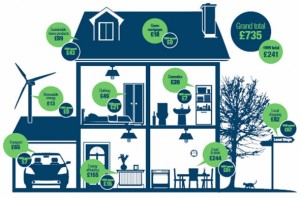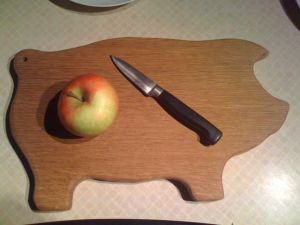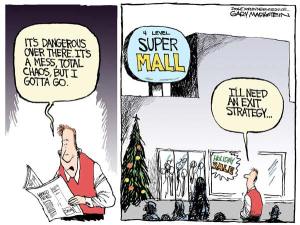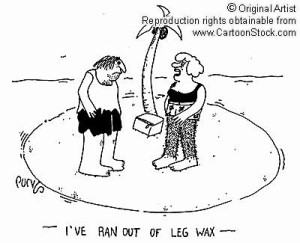I’m taking a departure from my usual farm updates to share some of my recent thoughts about consumerism and the STUFF we bring into our homes and our lives.
It’s increasingly common to hear people asking about where their food comes from, particularly in communities like ours with their heavy focus on local food producers and small farms. People are starting to look at a food item in the grocery store and ask questions: where was this grown and under what conditions? who tended to this crop and were they paid a fair wage? how far did this item travel to get to me? what exactly is IN or ON this food that I might be concerned about? how much real nutrition is in this food item (i.e. how useful is it for my body)?
After having practiced this conscious consideration of the food I put on my family’s table for years now, it naturally began to extend to other areas of my life. Lack of time and budget makes it tempting and easy to pick up cheap, mass-produced goods. I have to steer myself away from the very low-priced (and usually, low-quality) kids clothes in our local Superstore when I do my grocery shopping, or that inexpensive sweater that would add a pick-me-up to my day without putting a crimp in my bank account. But with the Holiday Season approaching to remind us of the rampant consumerism that plagues our society I am making a conscious effort to steer away from those things and to think carefully about every item that enters my home.
It started when I was writing in my “Dream Home Journal” – this is a collection of thoughts, ideas, sketches etc. that I am putting together in anticipation of building a proper house for ourselves on the property. Having moved plenty of times over the years and being a fond practitioner of Decluttering, I was struck by the idea that every item in our new home should be consciously chosen. As much as possible, that is. I can’t afford to replace our mass-produced, fake-wood bookcases all at once. But I will need new items, as one always seems to when moving, like perhaps some rugs or something to put on the walls. And here’s where I would like to be particularly conscious in my choices.
I’ll give you an example of what I mean: I’ve had two “decorative” glass jars for several years now. I bought them at Ikea, on a whim, because they went with the colour scheme I’d chosen for the living room in our rented house. The jars serve no purpose – they are not functional and could not be put to any practical use. They were mass-produced on factory assembly lines in Asia and sold cheaply by the millions. They sat on our fireplace mantle as part of an arrangement of objects that was supposed to “harmonize the room’s colour scheme while being attractive and suited to the room’s style”. They have no meaning for me. There was no artist whose hands and creative spark touched them, they weren’t a well thought-out gift from a loved one. They are just items that take up space and need to be dusted.
To me these jars represent all that is thoughtless and mindless about consumerism. Right now they sit on my bedroom dresser, a faded pink three-drawer Ikea unit sandwiched in between two identical ones in fake brown wood finish. The bedroom in our ugly old mobile home is wallpapered in some tacky 80’s country rose pattern that clashes with everything else. The jars look ridiculously out of place, both in style and in colour. But I have kept them there because every time I dust them I’m reminded of how silly such items are, how easy it is to acquire such things, and what a colossal amount of money the average consumer throws away on such things over the course of our lifetimes.
I’ve decided that, in our new home, decorative items will be displayed because there is a story behind them. Perhaps one of the kids made it for me, or it was a gift from someone special who put their heart into it. It may be a souvenir from an important event or experience in my life. It may be from a local artist I admire and, if so, will definitely be handmade from natural materials. It may even be made by myself as I pursue my growing love of fibre art.
Another example: I have some plastic cutting boards (Ikea again!) that I don’t like and they are starting to really show their age. Despite my mother’s insistence that plastic is “hygenic” because you can put it in the dishwasher, some of mine are showing signs of mold/mildew in the cracks and cuts and I’m having to soak them in bleach. I have a wooden cutting board. One is pine strips glued together (yes, it’s also from Ikea) and it is really not holding up well (which I should expect given that it cost me $5). It’s warping and splintering and I realized I don’t even know where the wood came from, or how it was harvested and I don’t know what sort of glue was used to hold the bits together. I decided I was going to ask for a proper, handmade wooden cutting board for Xmas – the kind I see at the farmer’s market. Then a couple weeks ago I was at a local Xmas Fair held at a therapeutic farming community and I found a guy who made cutting boards from fallen Garry Oak. The Garry Oak is native to the Pacific West Coast and our island is home to some of the few remaining Garry Oak ecosystems, which harbour a number of rare species of wildlife. Now that has meaning for me. The cutting boards were carved by the man who was selling them and he explained to me how to oil it regularly to keep it in good shape. When I saw he had one carved into the shape of a pig I knew destiny had led me to his table. I treated myself to the board and it was only $15. Sure, that’s five times more than the cheap-ass one from Ikea, but you get what you pay for, right?
And so as we head through the holiday season and I put together my Xmas gifts I’m trying to be conscious about these things. On a recent trip to Vancouver my mother and I went shopping. It was a very rare treat for me to be able to spend a day with my mother without kids in tow, but honestly the Mall was not the attraction for me. It was spending time with her (and the sushi lunch we had!). As I wandered the stores all I could see was masses and masses of…stuff! Stuff I didn’t need, stuff I didn’t even want until I saw it all done up so nicely in the displays. I passed a window with a lovely fair-isle style sweater and thought “oh, that looks nice” and then I thought to myself “Chain store, likely made in India by poorly paid workers, ten million of them released this season, then by next season they’ll be on the clearance rack because they’ll be ‘so last year'”. That took all the yearning for the sweater out of my head. Not to mention the fact that I’ve always wanted to try Fair Isle knitting and one day I’ll either make one myself or buy it from a local fiber artist. That is worth waiting for (or saving up for).
I’m pretty good at steering clear of “shopping as a hobby”. I do think about the things I buy and I strive to be frugal and keep clutter down to a minimum. Truth is I buy very little. But around Xmas I tend to go into a frenzy of buying stuff I normally wouldn’t because I feel the pressure of this time of year.
So over the next couple of weeks as you make up your gift lists (and wish lists for yourself), think about the things coming into your home and the things you are sending into others’ homes. Ask the same questions you would about your food: where did this come from? who made it? who tended to it? were they treated well and paid fairly? And ask some more questions: is this well-made and useful and will it last? or will I be chucking it out in a few months?





















